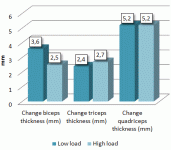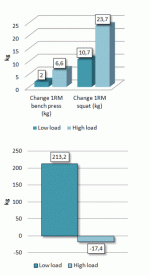Strength training with high reps great for building muscle mass, not for building strength
If you do weight training to build muscle mass, you may as well use weights that you can do 30 reps with instead of weights that you can only manage 10 reps with, American sports scientist Brad Schoenfeld discovered. But if your aim is strength gain, high reps resistance training is less suitable.
Study
Schoenfeld did an experiment with 18 young men, who had been doing weight training on average for over three years.
Schoenfeld divided the men into two groups, all of whom did a full body workout three times a week for eight weeks. The subjects did seven basic exercises: bench-press, military-press, lat-pulldown, cable-row, squat, leg-press and leg-extension. They did to-failure sets.
Half of the subjects trained using weights that were 70-80 percent of the weight at which they could just manage 1 rep [1RM]. Their sets consisted of 8-12 reps. [High load]
The other half of the subjects trained using weights that were 30-50 percent of the weight at which they could just manage 1 rep. Their sets consisted of 25-35 reps. [Low load]
Results
At the end of the eight weeks both groups had gained the same amount of muscle mass. Apparently for muscle mass it makes no difference whether you train with relatively heavy or light weights.
The weight with which the subjects could just manage 1 rep [1RM] increased by more in the High load group than in the Low load group. The increase in 1RM for the bench press in the Low load group was not even statistically significant.
But by the end of the experiment the subjects in the Low load group were able to perform more reps when they did bench presses with 50 percent of their 1RM. The figure above shows that the total number of kilograms that the subjects in the High load group were able to shift in a to-failure set with 50 percent of their 1RM actually decreased a tiny amount – but not significantly.
Conclusion
"Low-load training can be an effective method to increase muscle hypertrophy of the extremities in well-trained men", Schoenfeld concluded. "The gains in muscle size from low-load training were equal to that achieved with training in a repetition range normally recommended for maximizing muscle hypertrophy."
"Provided that maximal hypertrophy is the primary outcome goal irrespective of strength increases, these findings suggest that a new paradigm should be considered for hypertrophy training recommendations, with low-load training promoted as a viable option."
"On the other hand, if maximizing strength gains is of primary importance, then heavier loading should be employed at the exclusion of lower load training."
Source: J Strength Cond Res. 2015 Oct;29(10):2954-63.
If you do weight training to build muscle mass, you may as well use weights that you can do 30 reps with instead of weights that you can only manage 10 reps with, American sports scientist Brad Schoenfeld discovered. But if your aim is strength gain, high reps resistance training is less suitable.
Study
Schoenfeld did an experiment with 18 young men, who had been doing weight training on average for over three years.
Schoenfeld divided the men into two groups, all of whom did a full body workout three times a week for eight weeks. The subjects did seven basic exercises: bench-press, military-press, lat-pulldown, cable-row, squat, leg-press and leg-extension. They did to-failure sets.
Half of the subjects trained using weights that were 70-80 percent of the weight at which they could just manage 1 rep [1RM]. Their sets consisted of 8-12 reps. [High load]
The other half of the subjects trained using weights that were 30-50 percent of the weight at which they could just manage 1 rep. Their sets consisted of 25-35 reps. [Low load]
Results
At the end of the eight weeks both groups had gained the same amount of muscle mass. Apparently for muscle mass it makes no difference whether you train with relatively heavy or light weights.
The weight with which the subjects could just manage 1 rep [1RM] increased by more in the High load group than in the Low load group. The increase in 1RM for the bench press in the Low load group was not even statistically significant.
But by the end of the experiment the subjects in the Low load group were able to perform more reps when they did bench presses with 50 percent of their 1RM. The figure above shows that the total number of kilograms that the subjects in the High load group were able to shift in a to-failure set with 50 percent of their 1RM actually decreased a tiny amount – but not significantly.
Conclusion
"Low-load training can be an effective method to increase muscle hypertrophy of the extremities in well-trained men", Schoenfeld concluded. "The gains in muscle size from low-load training were equal to that achieved with training in a repetition range normally recommended for maximizing muscle hypertrophy."
"Provided that maximal hypertrophy is the primary outcome goal irrespective of strength increases, these findings suggest that a new paradigm should be considered for hypertrophy training recommendations, with low-load training promoted as a viable option."
"On the other hand, if maximizing strength gains is of primary importance, then heavier loading should be employed at the exclusion of lower load training."
Source: J Strength Cond Res. 2015 Oct;29(10):2954-63.


